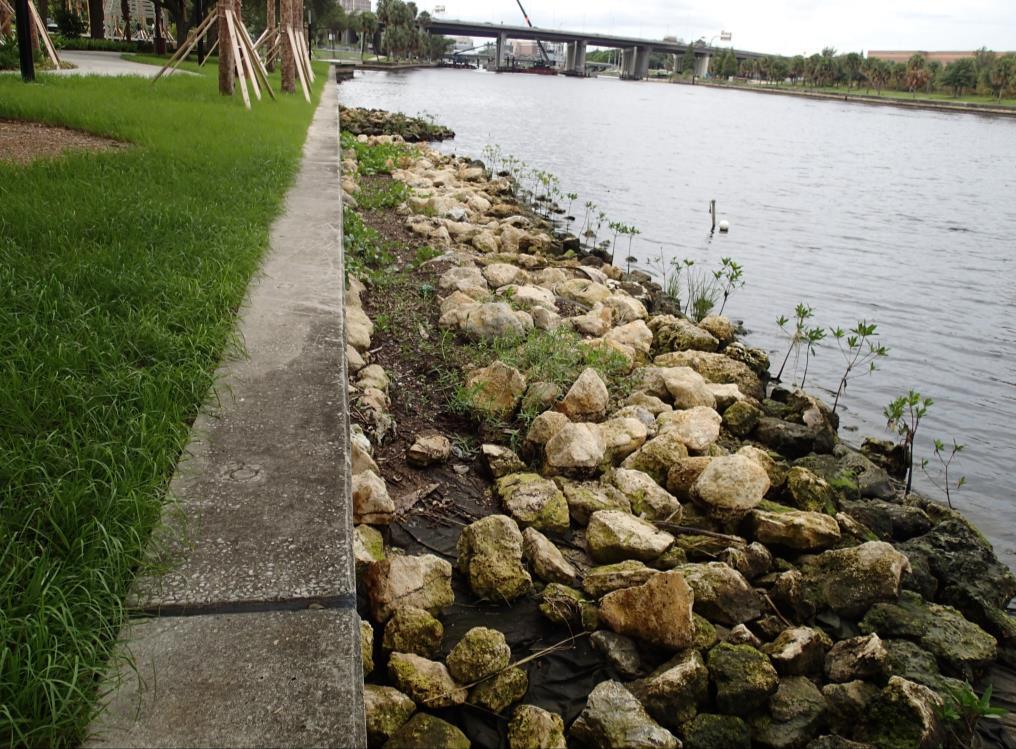
Published
October 10, 2023
Contact
Shawn College, AICP – [email protected] – 813-272-5940
Last updated
October 10, 2023
Coastal areas around the world are under constant threat from erosion, rising sea levels, and extreme weather events. To combat this, property owners and municipalities must consider protective measures such as seawalls and living shorelines. While both options aim to mitigate erosion and protect property, there are significant differences in their environmental and long-term impacts.
Natural Erosion Control
A living shoreline is a more ecologically friendly approach to coastal protection. It involves the use of native plants, vegetation, and sometimes even oyster reefs to stabilize the shoreline. These natural elements work together to absorb wave energy and create a habitat for wildlife. Living shorelines also adapt to changing conditions and provide a more resilient barrier against erosion.
Seawalls are hard structures made of concrete, steel, or stone that act as a rigid barrier against the sea. While they can be effective in the short term, they often exacerbate erosion in adjacent areas due to the deflection of wave energy. Seawalls also prevent the natural transfer of sediment and nutrients, harming local ecosystems and fisheries.
Habitat Creation
One of the most significant advantages of living shorelines is their ability to create and support diverse ecosystems. Native plants and submerged vegetation provide essential habitat for fish, crabs, and various bird species. These habitats contribute to increased biodiversity and healthier coastal ecosystems.
Seawalls, however, offer no habitat value and can negatively impact local wildlife. They disrupt the natural flow of water and inhibit the growth of vegetation, reducing food and shelter availability for aquatic and terrestrial species.
Resilience to Climate Change
As sea levels rise and storms become more frequent and intense, the flexible nature of living shorelines allows them to adjust and remain effective. They also absorb and dissipate storm energy, reducing the risk of damage to the shoreline and adjacent properties.
Seawalls are often susceptible to damage during extreme weather events, and repairs can be costly and time-consuming. As sea levels rise, seawalls may need frequent repairs or heightening to remain effective, making them less adaptable to changing conditions.
Aesthetics and Property Value
Living shorelines have a natural and aesthetically pleasing appearance that blends with the coastal environment. They enhance property values by providing scenic beauty and recreational opportunities. Many homeowners prefer living shorelines for their visual appeal.
Seawalls can be visually unappealing and may negatively affect property values. Their imposing structure can obstruct scenic views and access to the waterfront.
While seawalls have historically been a common choice for coastal protection, the benefits of installing a living shoreline are becoming more recognized. Living shorelines offer natural erosion control, create valuable habitats, adapt to changing climate conditions, and enhance the aesthetics and property values of coastal areas. The City of Tampa has seen several living shoreline projects installed in the lower Hillsborough River in recent years on public shores. Examples of these are Water Works Park, Ulele Springs, Stewart Middle School, and Cotanchobee and USF Parks. The Environmental Protection Commission of Hillsborough County now provides homeowners a 50% reduction in fees for the permitting of a living shoreline instead of a seawall. In the face of rising sea levels and climate change, the ecological and long-term advantages of living shorelines make them a compelling choice for sustainable coastal protection.
Read more about living shorelines at the links below:
- A hands-on guide to building living shorelines in Florida
- Restore America’s Estuaries pages (including a video) on living shorelines
- Florida Department of Environmental Protection’s work in the Panhandle
- NOAA’s page on living shorelines
- The Southern Environmental Law Center’s page on shorelines, including a national forum on the topic




